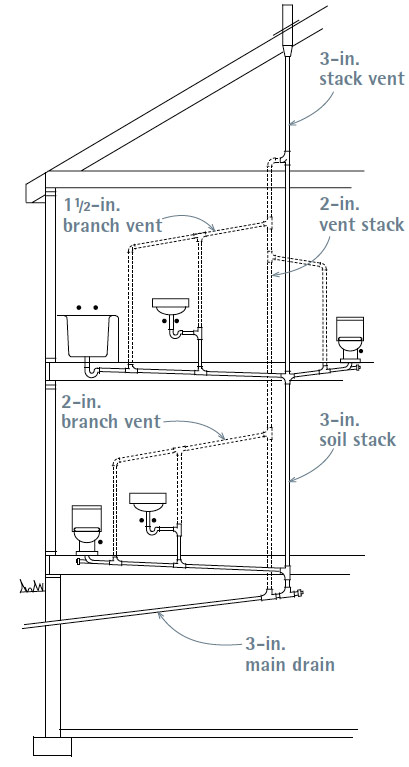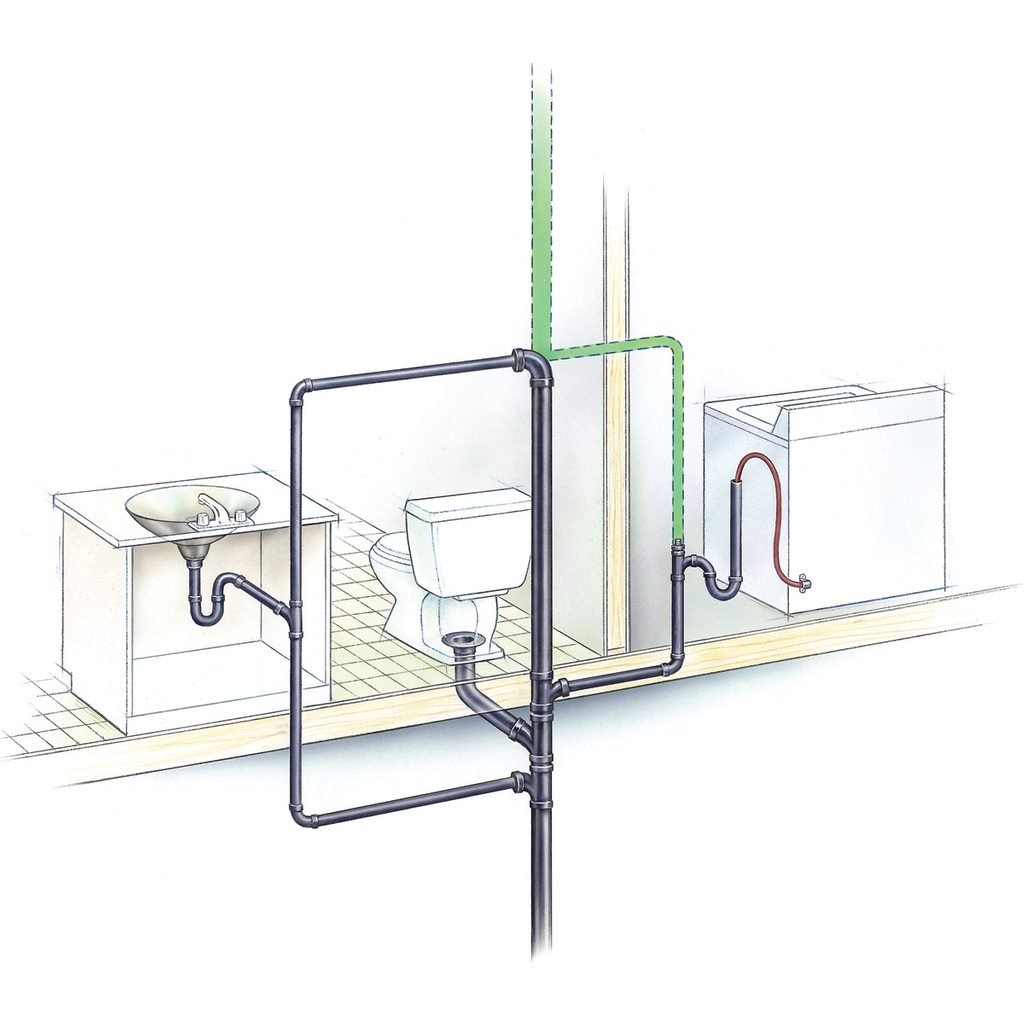The Essential Role of Correct Ventilation in Plumbing Systems
The Essential Role of Correct Ventilation in Plumbing Systems
Blog Article
What're your opinions with regards to What Is A Plumbing Vent & How Do They Work??

Appropriate air flow in pipes systems is commonly ignored, yet it is crucial for preserving the capability and safety and security of your home's pipes. Ventilation helps control air pressure, stop the build-up of hazardous gases, and make certain the efficient removal of waste. In this overview, we will check out the significance of correct plumbing ventilation, just how it works, and the advantages it brings to your pipes system.
Recognizing Air Flow in Pipes
Air flow in plumbing describes the network of pipes that enable air to move through the drain system. These vents offer numerous functions, including managing air pressure within the pipes, protecting against sewage system gases from going into the home, and aiding in the smooth circulation of wastewater.
Exactly How Ventilation Works in Pipes Systems
Air Pressure Law
Correct air flow maintains well balanced air pressure within the plumbing system. When water streams via pipelines, it displaces air. Without ample ventilation, this displacement can develop adverse pressure, bring about slow down drains pipes or siphoning of water from traps, which can create unpleasant odors to leak right into the home.
Avoiding Drain Gas Build-up
Among the most vital functions of plumbing vents is to stop sewer gases, such as methane and hydrogen sulfide, from building up within the home. These gases can present severe wellness risks and are extremely flammable. Vent pipes allow these gases to escape securely outdoors.
Aiding in Waste Elimination
Ventilation aids in the efficient removal of wastewater by avoiding airlocks in the drainage system. When air can flow openly with the vents, it allows water and waste to stream efficiently with the pipes, minimizing the risk of obstructions and backups.
Kinds Of Pipes Vents
Main Stack Vent
The major pile air vent, additionally referred to as the air vent stack, is the key vent in a pipes system. It extends from the main drain align with the roof covering, allowing gases to escape and fresh air to go into the system.
Branch Vent
Branch vents connect to the major pile air vent and serve specific components, such as sinks, toilets, and showers. These vents guarantee that each component has adequate air flow to function appropriately.
Air Admittance Shutoff (AAV).
An Air Admission Valve (AAV) is a one-way valve that allows air to go into the pipes system without the requirement for a traditional air vent pipeline prolonging with the roofing system. AAVs are generally utilized in restorations or locations where mounting a conventional vent is unwise.
Signs of Poor Ventilation in Pipes.
Slow Draining Fixtures.
If your sinks, bathtubs, or bathrooms are draining pipes slowly, it could be an indicator of poor ventilation. Insufficient air circulation can produce a vacuum result, making it challenging for water to drain correctly.
Gurgling Seems.
Gurgling noises originating from drains are typically a result of air being drawn through water traps because of negative stress in the pipes. This is a clear indication of inadequate ventilation.
Unpleasant Odors.
Drain smells inside your home are a red flag that your plumbing system is not properly aerated. This can mean that drain gases are not being effectively aired vent outside, leading to possibly dangerous problems.
Typical Air Flow Mistakes.
Inadequate Vent Sizing.
Using undersized vent pipelines can bring about poor air circulation and pressure discrepancies in the system. It's vital to use vents that meet the particular needs of your pipes system.
Improper Vent Placement.
Putting vents also far from the components they serve can minimize their effectiveness. Proper placement ensures that air can stream freely and efficiently with the system.
Disregarding Code Demands.
Building ordinance provide details standards for pipes ventilation. Ignoring these codes can lead to a system that falls short to work appropriately and might lead to pricey fixings or health hazards.
Benefits of Correct Ventilation.
Boosted System Effectiveness.
Correctly ventilated pipes systems operate more efficiently, with fewer clogs, faster draining, and less stress on the pipes. This performance prolongs the life-span of the pipes system.
Improved Air Top Quality.
By stopping drain gases from entering your home, correct ventilation contributes to far better indoor air quality, making your living environment healthier and much more comfy.
Stopping Water Damages.
Adequate ventilation assists protect against water from being siphoned out of traps, which can bring about sewage system gases getting in the home and triggering water damage in time.
Steps to Guarantee Correct Ventilation.
Consulting Plumbing Codes.
Always consult neighborhood plumbing codes when designing or customizing your plumbing system. These codes offer the essential standards for proper venting and guarantee your system satisfies security standards.
Regular Assessment and Maintenance.
Regular inspections can aid recognize prospective ventilation concerns prior to they become major troubles. Maintenance tasks, such as cleaning vent pipes and looking for blockages, are vital for keeping the system in good working order.
Specialist Installation.
For brand-new installments or significant modifications, it's wise to hire an expert plumbing professional. They have the proficiency to ensure the air flow system is correctly created and installed according to code.
Verdict.
Proper ventilation is a vital element of any pipes system, making certain that it functions effectively and securely. By recognizing the importance of ventilation, recognizing the indications of poor ventilation, and taking steps to keep your system, you can avoid expensive concerns and shield your home's air high quality.
4 Things You Should Know About Your Plumbing Vents
What Plumbing Vents Are
Also called a vent stack, a plumbing vent is a vertical pipe attached to your drain line that runs through your roof. The plumbing vent pipe, or plumbing air vent, removes gas and odors from your plumbing system and allows fresh air to enter the pipes, helping the water to flow out of the drain pipes.
What Plumbing Vents Do
Plumbing vents have two basic functions. One of which is to allow unpleasant smelling wastewater and sewer gasses to escape your plumbing system instead of entering your home. Plumbing vent pipes are typically located on roofs, away from windows, to ensure the fumes exit the home completely.
The other function of the plumbing vent is to move fresh air into your plumbing system. This helps move water through every plumbing fixture in your house, like toilets and sink drains. Think of the way in which you need to let a little air into the bottle as you pour soda in order to make the drink flow smoothly.
Different Types of Plumbing Vents
True vent: This is the most common vent option. In simplest terms, a true vent is a vertical pipe attached to your drain line that exits through the roof. They often function as the main vent that other fixtures can connect to. Re-vent pipe or auxiliary vent: Attached to the drain line near specific plumbing fixtures, re-vent pipes run up and over to connect to the main vent. Common vent: Two plumbing fixtures installed on opposite sides of a wall are typically tied into the vent stack using something known as a sanitary cross. Wet vent: This venting option operates as a drain pipe and a vent at the same time. Wet vent drainage systems drain water from one fixture while venting the air from another. Although they’ve been used for over 100 years, wet vent systems have only recently been added to the plumbing code in many areas. If you’re planning on installing one in a bathroom remodel, make sure you check your local code prior to construction. Loop vent: For free-standing fixtures like kitchen island sinks, loop vents are ideal. These vent pipes run under the floor, rise from the P-trap, and create a loop inside the cabinet sink. Air admittance valve: An AAV is a one-way mechanical valve typically installed at the site of the plumbing fixture. AAVs allow venting to occur without having to tie into a larger venting system. They’re ideal for venting fixtures where you aren’t able to easily connect to an existing vent system. Common Plumbing Vent Issues
Although vent pipes typically don’t have water flowing through them, they’re still subject to many typical plumbing issues. For example, clogs are one of the most common problems associated with sewer vent pipes. If your vent pipe gets clogged, all of your plumbing fixtures tied into the vent stack will be affected.
A sink with a slow drain that bubbles and gurgles or a strong sewage smell around your toilet are both indicators that your toilet vent pipe is clogged. Because most vent pipes exit through the roof, old leaves, twigs or even a bird’s nest could be clogging the pipe.
Clogs in your vent pipe system cause a buildup of negative pressure, meaning that water won’t be able to flow out of your home very well. It’s similar to putting your finger over the opening of a straw to trap water inside. When you remove your finger, the water is able to flow out of the straw.
If you suspect you have any blockage in your vent, make sure you have a professional come examine the situation. Left unchecked, a blocked air vent can lead to other costly repairs, like leaks and sediment buildup.
Under Pressure
Pipe vents are essential aspects of a home’s plumbing system. Owning a home means learning about all sorts of things you never put much thought into before. But by understanding as much as you can about the important systems of your home, you can keep those budgets intact and those anxiety levels low.
https://www.homeserve.com/en-us/blog/home-improvement/plumbing-vents/

I'm certainly very inquisitive about What Are Plumbing Vents and Why Are They Important? and I'm hoping you enjoyed the new blog entry. So long as you enjoyed our blog post if you please consider to share it. We enjoy reading our article about What Is A Plumbing Vent & How Do They Work?.
Suggested Site Report this page